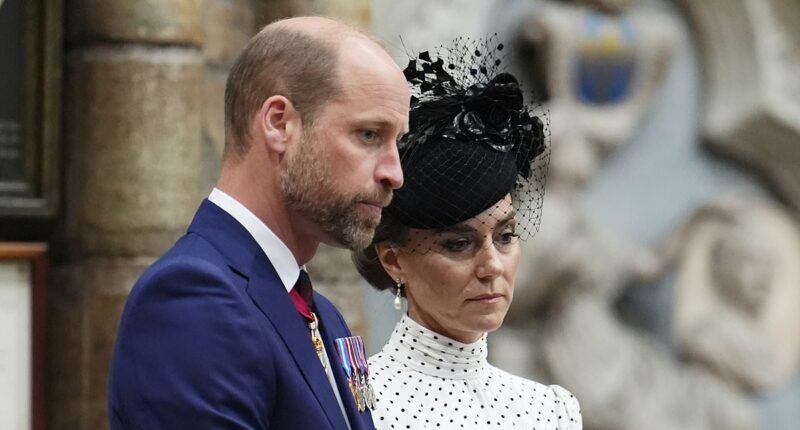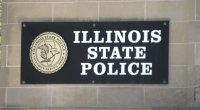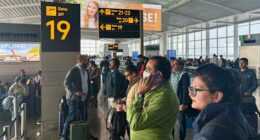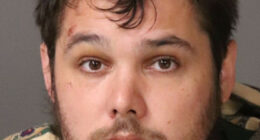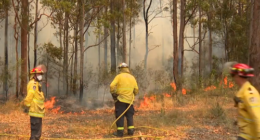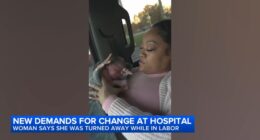Share this @internewscast.com
The Prince of Wales was at the helm, steering his family to the Sunday church service in Balmoral today, with the Princess of Wales smiling in the front seat beside him.
Princess Charlotte enjoyed the journey from the back seat, accompanied by her brothers, Prince George and Prince Louis, both dressed sharply in coordinated outfits for the event.
King Charles III and Queen Camilla, along with The Princess Royal, joined the Wales family, all making their way to Crathie Kirk to spend a segment of their Bank Holiday weekend at the church.
The monarch embarked on his usual summer retreat at Balmoral last week, with several Royal Family members gathering to relish their holiday together.
William, 43, appearing a calm and collected driver, looked smart in a suit and tie as he sat behind the wheel.
Meanwhile, Kate, also 43, looked graceful in a black hat adorned with a structured bow, a textured jacket, and a maroon top, smiling as she sat next to William.
Charlotte, 10, peered out the window with a curious look, her hair tidily pulled back, donned a cream cardigan over a polka dot dress—echoing her mother Kate’s favorite pattern.
During the drive, it appeared Prince George, 12, was deep in conversation with Prince Louis, seven, whose eyes were large as he looked up at his big brother.

The Prince and Princess of Wales are seen driving their three children to Sunday church service in Balmoral

Princess Charlotte rode in the back seat of the car along with her brothers, Princes George and Louis, as the whole family spends their day out
The King and Queen, who were driven to the church, appeared serious as they looked at the car journey ahead.
The monarch, 76, wore a pale pink shirt under his smart suit, complete with a tartan tie, a nod to the Scottish Highlands they are currently residing in.
Queen Camilla, 78, was seen wearing a hat with a jaunty feather and a multicoloured print dress, as well as a large cream shawl draped over her shoulder to keep her warm.
Princess Anne, 75, was dressed in the most colourful ensemble of the whole family, wearing a turquoise blouse with a large collar, as well as a matching jacket and hat.
Going to church is a tradition that King Charles follows closely, having driven himself and Queen Camilla to a service on Sunday August 17, also at Crathie Kirk.
Last week, His Majesty’s attendance came after the royal couple were moved to tears by the powerful first-hand testimony of VJ veterans as they spoke at a service of remembrance marking 80 years since the end of the Second World War.

Princes George (left) and Louis appeared deep in conversation as Louis looked up at his older brother during the car journey

Prince George scored the middle seat in the family’s Range Rover, so he was sat right between William and Kate

Princess Kate was a picture of elegance, wearing a black hat with an embellishment, a textured blazer and a maroon blouse, with subtle gold jewellery

King Charles and Queen Camilla were also seen heading to the Sunday church service

The monarch officially began his annual summer residency in Balmoral, a tradition the Royal Family has upheld for decades, and is joined by other members of the family

At one point, the King and Queen rolled down their window slightly and Queen Camilla appeared to look directly at the camera whilst the monarch was in the middle of a sentence

The Princess Royal was also driven to the church service at Cathie Kirk, and was seen smiling in the car on the way there
Charles and Camilla were attending the Service of Remembrance at the National Memorial Arboretum in Staffordshire organised by the Royal British Legion in what made for a moving tribute to war heroes, where they were joined by Prime Minister Sir Keir Starmer.
It included two Fly Pasts, a two-minute silence, musical interludes and testimony from survivors of the so-called Forgotten War.
The Prince and Princess of Wales also shared a powerful message to social media praising the ‘courage, sacrifice, and resilience’ of those who fought in the Pacific and Far East on the 80th anniversary of VJ Day.
In a message posted on social media and signed with their initials, the royal couple wrote: ‘Today, on the 80th anniversary of VJ Day, we remember the courage, sacrifice and resilience of all who served.
Today we especially think of those British and Commonwealth troops who fought in the Asia-Pacific.
‘We owe an enduring debt to the generation who gave so much, and to whom we will always be grateful.

The Prince and Princess of Wales have shared a powerful message to social media to mark VJ Day (pictured at a service of thanksgiving for VE Day in May)
‘Lest we forget. W & C’.
VJ (Victory over Japan) Day on August 15 marks the anniversary of the end of the six-year war, following VE (Victory in Europe) Day back in May.
Their message came just hours after King Charles told the nation how the sacrifice of the heroes of VJ Day will never be forgotten.
In a moving audio message, echoing one broadcast by his grandfather, King George VI, eighty years ago, Charles described how those who lived and died in the Far East ‘gave us more than freedom; they left us the example of how it can and must be protected’.
The message was recorded earlier this month, in the Morning Room at Clarence House.
August 15, 1945, marked not only the cessation of war over Japan but the end of the Second World War as a whole.
More than 90,000 British troops were casualties of the Far East conflict, of which almost 30,000 died and over 12,400 were held as prisoners of war, in often horrific conditions.
But despite the magnitude and brutality of the conflict, many feel that their contribution was deliberately overlooked at the time and has continued to be forgotten over the years, particularly given the historic significance of events to mark Victory in Europe in May of that year.
The King issued a stark warning about the ‘true cost’ of armed conflict in his moving address to the nation marking the 80th anniversary of VJ Day.
His Majesty also hailed the ‘courage and camaraderie’ of heroes who fought in the Pacific and Far East in ‘humanity’s darkest hour’ as ‘a flame that shall blaze for eternity’.
And he acknowledged the devastation caused by the atomic bombing of Hiroshima and Nagasaki which led to Japan’s surrender, describing the ‘immense price’ on its citizens as one ‘we pray no nation need ever pay again’.

William and Kate, both 43, this morning praised the ‘courage, sacrifice, and resilience’ of those who fought in the Pacific and Far East

Their message came just hours after King Charles told the nation how the sacrifice of the heroes of VJ Day will never be forgotten
His reflection on the nuclear attacks, which paved the way for the end of the Second World War, comes at a time of increased concern about the global threat of nuclear conflict.
In an audio message to the nation, realms and Commonwealth, the King spoke of the horrors faced by allied prisoners of war ‘who endured years of brutal captivity: the starvation, disease and cruelty that tested the very limits of human endurance’, and the ‘mental and physical scars’ the war left on those who survived.
And he vowed the service and sacrifice of VJ Day heroes ‘shall never be forgotten’, telling their families and the ‘sadly dwindling band of veterans’: ‘Please know that the courage and camaraderie displayed in humanity’s darkest hour is a flame that shall blaze for eternity – a beacon that honours our past and guides our future.’
The King, in what is believed to be the most direct reference by a British monarch to the suffering in Hiroshima and Nagasaki, said it was right to pause and acknowledge the impact of the ‘war’s final act’ on the people of the Japanese cities.
‘Innocent civilian populations of occupied territories faced grievous hardships, too,’ he said in the broadcast released at 7.30am today.
‘Their experience reminds us that war’s true cost extends beyond battlefields, touching every aspect of life – a tragedy all-too vividly demonstrated by conflicts around the world today.
‘On this landmark anniversary, we should also pause to acknowledge that in the war’s final act, an immense price was paid by the citizens of Hiroshima and Nagasaki – a price we pray no nation need ever pay again.’
He added: ‘But in recalling so much suffering, we must not lose sight of how great was the cause and how sweet the victory.’

The Prince and Princess of Wales during the concert celebrating the 80th Anniversary of VE Day, held at the historic Horse Guards Parade in central London in May

King George VI, Queen Elizabeth and their daughters Princess Elizabeth and Princess Margaret wave to crowds from the Buckingham Palace balcony on VJ Day, August 15, 1945
Later today, the King, accompanied by Queen Camilla, will lead the national commemorations by attending a Service of Remembrance at the National Memorial Arboretum in Staffordshire organised by the Royal British Legion tomorrow.
Their Majesties will join veterans, members of VJ associations, military personnel and senior politicians for the event. However, the Prince and Princess of Wales are not expected to be present.
They will lay wreaths at the Armed Forces Memorial, before a national two-minute silence and a flypast from the RAF Red Arrows. There will also be a flypast by the Battle of Britain Memorial Flight of historic aircraft.
Afterwards they will meet with around 30 surviving veterans who served in the Pacific and Indian Ocean territories, those who were prisoners of war and veterans stationed throughout the UK and Commonwealth, who contributed to the war effort in the Far East.
By 1945, some 365,000 British and 1.5 million Commonwealth troops had been deployed across Asia and the Pacific.
More than 90,000 British troops were casualties in the war against Japan, and nearly 30,000 died, while more than 12,000 Britons were among the 190,000 Commonwealth troops held as Prisoners of War by the Japanese.
Of the Allied forces, the US suffered the greatest losses, with more than 100,000 killed in action.
In Hiroshima and Nagasaki, more than 200,000 people were killed by the US bombs and in the months after succumbing to radiation sickness, the effects of burns and other serious injuries.

Huge crowds celebrating Victory in Japan on August 15, 1945 in Albert Square, Manchester

Projections reading ‘VJ DAY 80’ are displayed on the exterior of Buckingham Palace on August 14
The King described the 80th anniversary as a day of ‘profound remembrance’ and said of his grandfather King George’s VI’s ‘The war is ended’ audio broadcast at the time: ‘Seldom can a simple message have resonated with such a potent mix of relief, celebration, and sorrow for those who never lived to see the glow of freedom’s new dawn.’
He also painted a vivid picture of when ‘high above those monsoon-lashed jungles, allied pilots displayed their own fearless bravery, flying fighters, bombers and transport aircraft into enemy fire and nature’s fury’.
The speech made no mention of the King’s father Prince Philip, the late Duke of Edinburgh, who was in Tokyo Bay on board the destroyer HMS Whelp, a warship he served on as second-in-command, when Japanese officials formally signed the surrender on the USS Missouri on September 2 1945.
But Charles paid tribute to his mentor and great uncle Earl Mountbatten, who oversaw the defeat of the Japanese offensive towards India as Supreme Allied Commander South East Asia Command.
He recalled how Lord Mountbatten taught him about the ‘horrors and heroism’ of the conflict.
The King said: ‘The war in South East Asia had reached its climax under the leadership of my great uncle, Lord Mountbatten, from whom I learned so much about the particular horrors and heroism witnessed in those furthest fields of combat.
‘The forces aligned under him comprised over one million men and women, drawn from many different countries, religions and communities, but united by common purpose and indomitable spirit.’
Charles said he was aware of the ‘mental and physical scars’ the conflict left on those who survived.
‘Twenty-Nine Victoria Crosses bear eloquent testimony to their valour, but I know full well of the toll it took on so many – measured not only in gravestones, but in the mental and physical scars of those who survived,’ he said.
He also cited the collaboration across faiths and cultural divides, saying: ‘Together they proved that, in times of war and in times of peace, the greatest weapons of all are not the arms you bear, but the arms you link.
‘That remains a vital lesson for our times.’
